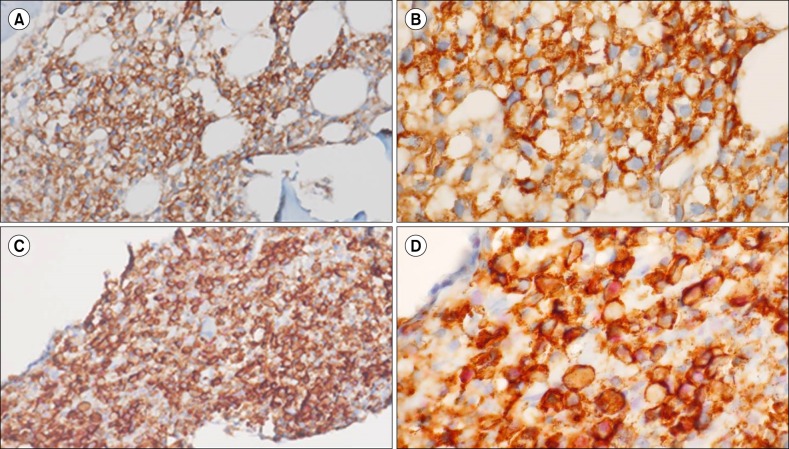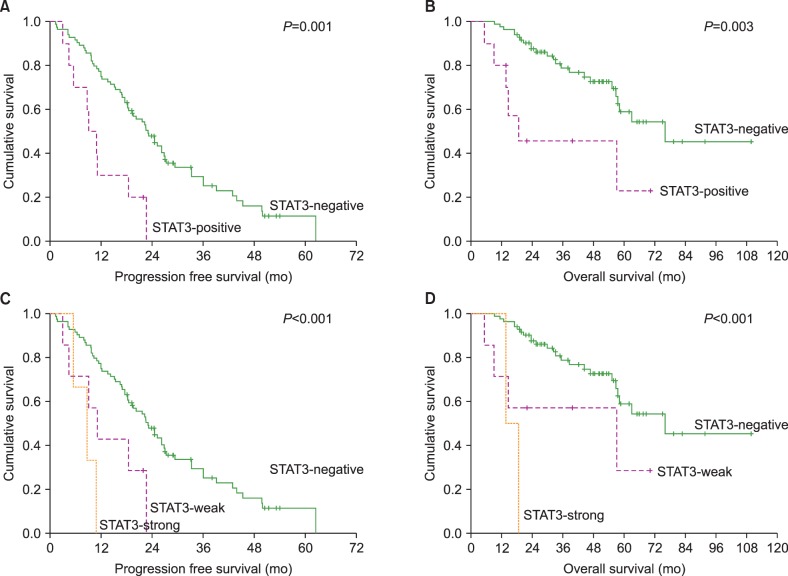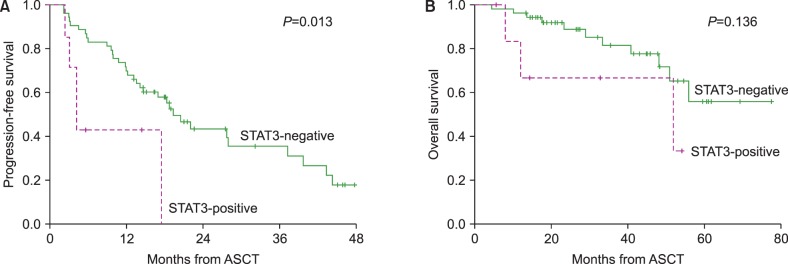Blood Res.
2017 Dec;52(4):293-299. 10.5045/br.2017.52.4.293.
STAT3 expression is associated with poor survival in non-elderly adult patients with newly diagnosed multiple myeloma
- Affiliations
-
- 1Department of Hematology-Oncology, Chonnam National University Hwasun Hospital, Hwasun, Korea. drjejung@chonnam.ac.kr
- 2Department of Laboratory Medicine, Chonnam National University Hwasun Hospital, Hwasun, Korea.
- KMID: 2405066
- DOI: http://doi.org/10.5045/br.2017.52.4.293
Abstract
- BACKGROUND
Signal transducer and activator of transcription 3 (STAT3) is not only a key signaling molecule in the regulation of growth but is also involved in malignant transformation. We investigated the prognostic significance of STAT3 expression in 94 non-elderly adult patients (aged 38 to 65 yr) with newly diagnosed multiple myeloma (MM).
METHODS
Tumor cell-specific phosphotyrosine-STAT3 (PY-STAT3) expression at the time of diagnosis was evaluated with dual immunohistochemical (IHC) staining for PY-STAT3 and CD138.
RESULTS
PY-STAT3 positivity was detected in 10 patients (10.6%), including three who showed strong expression. PY-STAT3-positive patients had higher serum C-reactive protein and calcium levels at diagnosis than did PY-STAT3-negative patients. PY-STAT3 positivity had predictive value for poor progression-free survival (PFS; P=0.001) and overall survival (OS; P=0.003). Among the 60 patients who received frontline autologous stem cell transplantation, PY-STAT3-positive patients had poorer PFS than did PY-STAT3-negative patients (4.2 vs. 19.2 mo, respectively; P=0.013). Multivariate analysis identified PY-STAT3 expression as an independent prognostic factor for PFS (relative risk [RR]=2.706, P=0.014) and OS (RR=3.091, P=0.044).
CONCLUSION
These data show that PY-STAT3 positivity, as determined using dual IHC, is a marker of poor prognosis in non-elderly adult patients with MM.
Keyword
MeSH Terms
Figure
Reference
-
1. Raab MS, Podar K, Breitkreutz I, Richardson PG, Anderson KC. Multiple myeloma. Lancet. 2009; 374:324–339. PMID: 19541364.
Article2. Kumar SK, Rajkumar SV, Dispenzieri A, et al. Improved survival in multiple myeloma and the impact of novel therapies. Blood. 2008; 111:2516–2520. PMID: 17975015.
Article3. Kumar SK, Dispenzieri A, Lacy MQ, et al. Continued improvement in survival in multiple myeloma: changes in early mortality and outcomes in older patients. Leukemia. 2014; 28:1122–1128. PMID: 24157580.
Article4. Bianchi G, Ghobrial IM. Biological and clinical implications of clonal heterogeneity and clonal evolution in multiple myeloma. Curr Cancer Ther Rev. 2014; 10:70–79. PMID: 25705146.
Article5. Greipp PR, San Miguel J, Durie BG, et al. International staging system for multiple myeloma. J Clin Oncol. 2005; 23:3412–3420. PMID: 15809451.
Article6. Yu H, Lee H, Herrmann A, Buettner R, Jove R. Revisiting STAT3 signalling in cancer: new and unexpected biological functions. Nat Rev Cancer. 2014; 14:736–746. PMID: 25342631.
Article7. Lee H, Herrmann A, Deng JH, et al. Persistently activated Stat3 maintains constitutive NF-kappaB activity in tumors. Cancer Cell. 2009; 15:283–293. PMID: 19345327.8. Yu H, Pardoll D, Jove R. STATs in cancer inflammation and immunity: a leading role for STAT3. Nat Rev Cancer. 2009; 9:798–809. PMID: 19851315.
Article9. Darnell JE. Validating Stat3 in cancer therapy. Nat Med. 2005; 11:595–596. PMID: 15937466.
Article10. Nelson EA, Walker SR, Kepich A, et al. Nifuroxazide inhibits survival of multiple myeloma cells by directly inhibiting STAT3. Blood. 2008; 112:5095–5102. PMID: 18824601.
Article11. Kube D, Holtick U, Vockerodt M, et al. STAT3 is constitutively activated in Hodgkin cell lines. Blood. 2001; 98:762–770. PMID: 11468177.
Article12. Chiarle R, Simmons WJ, Cai H, et al. Stat3 is required for ALK-mediated lymphomagenesis and provides a possible therapeutic target. Nat Med. 2005; 11:623–629. PMID: 15895073.
Article13. Huang X, Meng B, Iqbal J, et al. Activation of the STAT3 signaling pathway is associated with poor survival in diffuse large B-cell lymphoma treated with R-CHOP. J Clin Oncol. 2013; 31:4520–4528. PMID: 24220563.
Article14. Catlett-Falcone R, Landowski TH, Oshiro MM, et al. Constitutive activation of Stat3 signaling confers resistance to apoptosis in human U266 myeloma cells. Immunity. 1999; 10:105–115. PMID: 10023775.
Article15. Bharti AC, Shishodia S, Reuben JM, et al. Nuclear factor-kappaB and STAT3 are constitutively active in CD138+ cells derived from multiple myeloma patients, and suppression of these transcription factors leads to apoptosis. Blood. 2004; 103:3175–3184. PMID: 15070700.16. Monaghan KA, Khong T, Burns CJ, Spencer A. The novel JAK inhibitor CYT387 suppresses multiple signalling pathways, prevents proliferation and induces apoptosis in phenotypically diverse myeloma cells. Leukemia. 2011; 25:1891–1899. PMID: 21788946.
Article17. Scuto A, Krejci P, Popplewell L, et al. The novel JAK inhibitor AZD1480 blocks STAT3 and FGFR3 signaling, resulting in suppression of human myeloma cell growth and survival. Leukemia. 2011; 25:538–550. PMID: 21164517.
Article18. Brown R, Yang S, Weatherburn C, et al. Phospho-flow detection of constitutive and cytokine-induced pSTAT3/5, pAKT and pERK expression highlights novel prognostic biomarkers for patients with multiple myeloma. Leukemia. 2015; 29:483–490. PMID: 24990616.
Article19. Xiong H, Du W, Wang JL, et al. Constitutive activation of STAT3 is predictive of poor prognosis in human gastric cancer. J Mol Med (Berl). 2012; 90:1037–1046. PMID: 22328012.
Article20. Yang C, Lee H, Jove V, et al. Prognostic significance of B-cells and pSTAT3 in patients with ovarian cancer. PLoS One. 2013; 8:e54029. PMID: 23326565.
Article21. Mantovani A, Allavena P, Sica A, Balkwill F. Cancer-related inflammation. Nature. 2008; 454:436–444. PMID: 18650914.
Article22. Kujawski M, Kortylewski M, Lee H, Herrmann A, Kay H, Yu H. Stat3 mediates myeloid cell-dependent tumor angiogenesis in mice. J Clin Invest. 2008; 118:3367–3377. PMID: 18776941.
Article23. Grivennikov S, Karin E, Terzic J, et al. IL-6 and Stat3 are required for survival of intestinal epithelial cells and development of colitis-associated cancer. Cancer Cell. 2009; 15:103–113. PMID: 19185845.
Article24. Offidani M, Corvatta L, Polloni C, et al. Serum C-reactive protein at diagnosis and response to therapy is the most powerful factor predicting outcome of multiple myeloma treated with thalidomide/ anthracycline-based therapy. Clin Lymphoma Myeloma. 2008; 8:294–299. PMID: 18854284.25. Tienhaara A, Pulkki K, Mattila K, Irjala K, Pelliniemi TT. Serum immunoreactive interleukin-6 and C-reactive protein levels in patients with multiple myeloma at diagnosis. Br J Haematol. 1994; 86:391–393. PMID: 8199033.
Article26. Ege H, Gertz MA, Markovic SN, et al. Prediction of survival using absolute lymphocyte count for newly diagnosed patients with multiple myeloma: a retrospective study. Br J Haematol. 2008; 141:792–798. PMID: 18410454.
Article27. Attal M, Harousseau JL, Stoppa AM, et al. A prospective, randomized trial of autologous bone marrow transplantation and chemotherapy in multiple myeloma. Intergroupe Français du Myélome. N Engl J Med. 1996; 335:91–97. PMID: 8649495.28. Child JA, Morgan GJ, Davies FE, et al. High-dose chemotherapy with hematopoietic stem-cell rescue for multiple myeloma. N Engl J Med. 2003; 348:1875–1883. PMID: 12736280.
Article29. Koreth J, Cutler CS, Djulbegovic B, et al. High-dose therapy with single autologous transplantation versus chemotherapy for newly diagnosed multiple myeloma: A systematic review and meta-analysis of randomized controlled trials. Biol Blood Marrow Transplant. 2007; 13:183–196. PMID: 17241924.
Article
- Full Text Links
- Actions
-
Cited
- CITED
-
- Close
- Share
- Similar articles
-
- STAT3, a Poor Survival Predicator, Is Associated with Lymph Node Metastasis from Breast Cancer
- Elevation of Serum Ferritin is Associated with the Outcome of Patients with Newly Diagnosed Multiple Myeloma
- Real-world evidence of levofloxacin prophylaxis in elderly patients with newly diagnosed multiple myeloma who received bortezomib, melphalan, and prednisone regimen
- Enhanced Protein Expression of Signal Transducer and Activator of Transcription 3 and Protein Kinase Substrate p36 in Hepatocellular Carcinoma
- bcl-2 and p53 Protein Expression in Multiple Myeloma and Non-tumorous Plasma Cells A study related to survival




